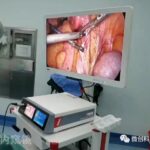Laparoscopy: Polycystic Ovary Perforation
Introduction
Surgical treatment of polycystic ovary syndrome(PCOS), can reduce some granulosa cells in the ovary, reduce the production of androgens in the ovarian stroma.
With the decrease of androgen level and GnRH, 90% ovulation rate and 70% pregnancy plate rate can be obtained after operation. Laparoscopic ovarian perforation has become a surgical treatment option for refractory PCOS with infertility.
Indication
- Patients with higher level of LH and free testosterone.
- Patients with clomiphene resistance.
Contraindication
- Operation is not recommended for patients with high BMI (>34).
- Polycystic ovarian changes caused by ovulation induction.
Surgical Procedures And Techniques
Note #1
After exploring the pelvis and abdominal cavity, use non-invasive forceps to clamp the suspensory ligament of ovary to lift the ovary (Fig. 1), and use bipolar electrocoagulation hook or electroacupuncture to drill holes at both sides of the ovary to reach the medulla (Fig. 2).
Note #2
Electrocoagulation for hemostasis of wound surface.
Note #3
Other steps are the same as the regular operation.
Note #4
Surgical skills:
- Drilling size: 8mm (depth) *2mm (diameter);
- Power: 30W;
- Perforations on each side: 4 holes are recommended, which can be treated individually according to the patient’s ovarian size, but the number of perforations should not be too large;
- Time: 5 seconds / hole.
Intraoperative risk and Prevention
1. Haemorrhage after ovarian electrocoagulation drilling under laparoscope.
Prevention:
Electrocoagulation can be used to stop bleeding if blood seeps through the hole after drilling. For patients with a large amount of bleeding, repeated electrocoagulation should be avoided, and 3-0 absorbable suture can be used for intermittent suture; But the suture should not be too much.
To avoid bleeding and persistent ovarian hypovascularization, no electrocoagulation within 8~10mm from the ovarian mesangium.
2. The most frequently injured organs are ureter and intestine.
Prevention:
When separating adhesion, pay attention to separating along the tissue gap and avoid rough and blunt separation. Do not attach the ovary to the fallopian tube during electrocoagulation drilling.
When it is difficult to separate adhesion, opening the retroperitoneum can reduce the injury of surrounding organs. In addition, attention should be paid to avoid accidental electrical injury of surrounding organs during operation.
3. Ovarian injury after ovarian electrocoagulation drilling, it is prone to thermal injury and electrical injury.
Prevention:
After drilling, rinse the ovarian surface with cold 0.9% sodium chloride solution, and suck away the smoke and hot gas in the pelvic cavity, so as to prevent the ovary from being damaged due to excessive temperature, and prevent intestinal burns and necrosis caused by excessive accumulation of hot gas in the pelvic cavity.
During hemostasis, the bleeding site shall be clearly seen, and extensive electrocoagulation is not allowed. Bipolar electrocoagulation should be used as far as possible to avoid unipolar electrocoagulation, so as to minimize the damage of electric heating to the follicles in the ovarian cortex.
Postoperative precautions
1. Pelvic Adhesion
During the operation, the damage to the ovarian surface should be reduced as much as possible. In addition to washing the pelvic cavity, anti adhesion drugs can be applied to the ovarian surface as appropriate.
2. Decreased ovarian function and premature ovarian failure
- Special attention should be paid to protect the ovary during operation to avoid the occurrence of premature ovarian failure after operation.
- Do not punch too many holes; It can be individualized according to the size of ovary, and usually 4 holes are drilled in each side of ovary.
- Do not drill too deep; Recommended single hole range: 8mm (depth) x 2mm (diameter).
- The power of electric coagulation drilling shall not be too large; Power 30w/ hole; Time 5 seconds / hole.
- Avoid perforating the ovary door.
- Do not blindly and extensively electrocoagulation to stop bleeding. Try to reduce the damage of electric heating to follicles in ovarian cortex.
- Limited to one treatment.
Thanks for reading, we hope you have enjoyed the content.
If you are looking for endoscopy equipment, feel free to check our product page or contact us at our contact page.




Leave a Reply
Want to join the discussion?Feel free to contribute!